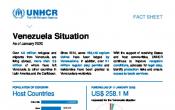Venezuela
Operation: Venezuela
Location
{"longitude":-65,"latitude":7,"zoom_level":0,"iso_codes":"'VEN'"}
By clicking on the icons on the map, additional information is displayed.
The boundaries and names shown and the designations used on this map do not imply official endorsement or acceptance by the United Nations.
Key Figures
| 2020 planning figures | |
| 277,520 | people with specific needs will receive material support |
| 309 | projects benefiting local and displaced communities implemented |
| 265 | community-based committees/groups working on SGBV prevention and response |
| 130 | interventions in local water systems will be completed |
| 96 | border monitoring visits will be conducted and recorded |
| 2017 year-end results | |
| 2,420 | asylum-seekers received information on government RSD procedures |
| 1,850 | border guards and government officials were trained on International Refugee Law |
| 750 | people of concern with specific needs were counselled on referral pathways and supported with material assistance |
| 240 | people of concern were referred to secondary and tertiary medical care |
| 200 | people of concern used existing government complaint mechanisms to claim their rights |
| 120 | Colombian people of concern were provided with safe and dignified return transportation |
Latest Updates
People of Concern
734%
Increase in
2019
2019
| 2019 | 562,307 |
| 2018 | 67,434 |
| 2017 | 123,714 |

[["Refugees",8945],["Refugee-like situation",58810],["Asylum-seekers",49],["Others of concern",494503]]
Loading ...
Venezuela
< Back
2019
{"categories":[2015,2016,2017,2018,2019,2020],"budget":[10.750133689,9.13229275,8.667207092,15.4806162,29.46500007,55.22669947],"expenditure":[4.36000157,3.96985401,4.07432946,6.49902097,19.20657611,null]}
{"categories":[2015,2016,2017,2018,2019,2020],"p1":[10.750133689,9.13229275,8.667207092,15.4806162,29.46500007,55.22669947],"p2":[null,null,null,null,null,null],"p3":[null,null,null,null,null,null],"p4":[null,null,null,null,null,null]}
{"categories":[2015,2016,2017,2018,2019,2020],"p1":[4.36000157,3.96985401,4.07432946,6.49902097,19.20657611,null],"p2":[null,null,null,null,null,null],"p3":[null,null,null,null,null,null],"p4":[null,null,null,null,null,null]}
Loading ...
CHOOSE A YEAR
- 2015
- 2016
- 2017
- 2018
- 2019
- 2020
Working environment
As of December 2018, more than 3 million Venezuelans have left for other countries in the region and beyond. Reasons cited for leaving included lack of food, medicine or essential social services, as well as incidents of violence and insecurity. Venezuelans continue to leave at an average of 5,000 a day.Fluctuating oil prices and a drop in production, increased international pressure and sanctions and continued hyperinflation and disparity between the official and unofficial exchange rates will impact negatively on the economy, resulting in increased hardship and poorer living conditions in Venezuela. The deterioration of infrastructure, public services and security may impact UNHCR’s operations in 2019.
Access to basic services also remains challenging. Limited access to formal schools is leaving many Venezuelan children without education. Limited access to health services, including chronic medication and treatment, puts Venezuelans with serious medical conditions at risk. The situation also affects asylum-seekers and refugees in Venezuela who are now returning to their country of origin.
Internal relocation of the population may continue to rise due to the widespread presence of organised and common crime.
Continuing restrictions to travel abroad for Venezuelans due to the serious constraints to obtain travel documents/passports as well as stricter measures in border areas had triggered an increase of exits using unofficial routes, resulting in increased risks.
Key Priorities
The main components of the UNHCR strategy in Venezuela are community-based protection, border monitoring, improvement of asylum processes and enhancement of solutions to people of concern, prevention of statelessness, as well as prevention and response to gender-based violence and child protection.In 2019:
- UNHCR will prioritize community-based interventions, protection monitoring, community empowerment and identification and referrals of persons with specific needs in 54 mixed communities in the country and will conduct UNHCR will engage UN agencies and other humanitarian actors in joint programmes to complement UNHCR’s community based activities in the spirit of the CRRF.
- UNHCR will consolidate five binational protection networks with organisations providing information, protection and assistance to people in transit.UNHCR will engage the Government of Venezuela to play a much more prominent role in achieving the objectives set out in the protection strategy, especially on asylum and solutions. In addition to the National Commission for Refugees (CONARE), UNHCR will also support the immigration authorities (SAIME) and oversight bodies like the Ombudsperson’s Office. Access to documentation for people of concern will be crucial and require close collaboration between UNHCR, CONARE and SAIME.
- Depending on funding availability, UNHCR will cover the documentation needs (civil status documents, passports) of all refugees. Otherwise UNHCR will only prioritise those who opt for facilitated voluntary repatriation.
- UNHCR will promote referral pathways, including transnational referrals of people in transit, and will expand its response through community networks.
- UNHCR will work to strengthen the capacity of border officials, health centers and Municipal Councils for the protection of children and adolescents in order to address the risk of SGBV and violations of children's rights.
- UNHCR will conduct sensitization sessions on birth registration for people in transit and indigenous communities, and will support Civil Registry offices to enhance their response capacity.






















